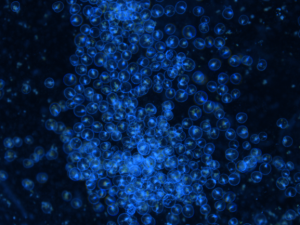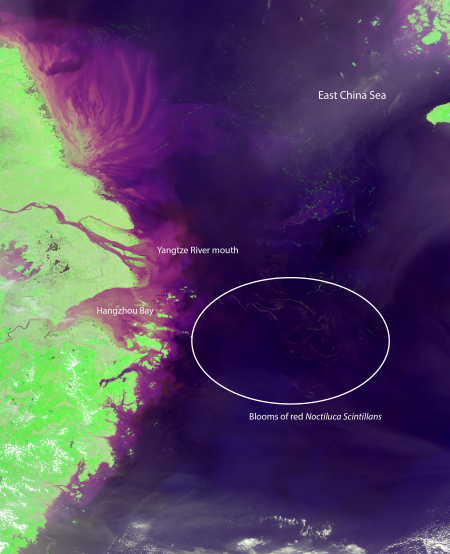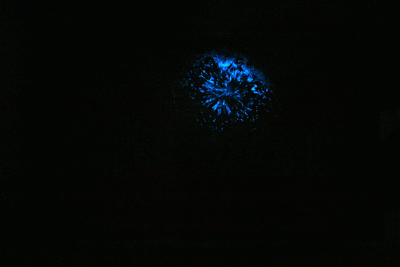
Blue bioluminescence produced by red Noctiluca scintillans near Taiwan’s Matsu Islands. Researchers now have a way to study the sparkly organisms by satellite.
Credit: Yu-Xian Yang, Lienchiang county government, Taiwan
AGU press contact:
Lauren Lipuma, +1 (202) 777-7396 (GMT-4), llipuma@agu.org
Contact information for the researchers:
Chuanmin Hu, University of South Florida (GMT-4), +1 (727) 553-3987, huc@usf.edu
Lin Qi, Xiamen University, China (GMT+8), lin.qi@xmu.edu.cn
Sheng-Fang Tsai, National Taiwan Ocean University (GMT+8), stsai@mail.ntou.edu.tw
WASHINGTON—Scientists have, for the first time, used satellites to track the bioluminescent plankton responsible for producing “blue tears” in China’s coastal waters and found the sparkly creatures have become more abundant in recent years.
Red Noctiluca scintillans are single-celled organisms found in coastal waters all over the world. Commonly known as sea sparkles, at night the organisms glow a bright blue when disturbed by swimmers, waves or passing boats. The sea sparkles’ dazzling blue light, often called “blue tears,” can be seen after dark on many of China’s shores and has become a major tourist attraction in recent years, especially in Taiwan’s Matsu Islands.
Blooms of Noctiluca scintillans are one form of red tides that can harm marine life, but scientists have difficulty monitoring these outbreaks. Researchers typically study the blooms by taking measurements from ships, but these measurements don’t show how the blooms are distributed over a large area of ocean or how they change over time.
Scientists report in a new study in AGU’s journal Geophysical Research Letters they have developed a way to track red Noctiluca scintillans blooms by satellite using the organism’s unique ability to absorb and scatter light.
The researchers used their new method to track red Noctiluca scintillans blooms in the East China Sea from 2000 to 2017. They found the twinkly creatures can survive farther from shore and in warmer waters than previously thought.
Their results also show red Noctiluca scintillans blooms have become more frequent in recent years and the organism’s abundance could have been affected by construction of the controversial Three Gorges Dam in the early 2000s.

Individual cells of red Noctiluca scintillans seen glowing blue under a microscope. The organism’s balloon-shaped bodies give them the buoyancy to float on the sea surface where humans can observe them.
Credit: Sheng-Fang Tsai, National Taiwan Ocean University
The new method will help researchers build a more complete picture of red Noctiluca scintillans blooms in this area, according to Lin Qi, an optical oceanographer at Sun Yat-Sen University in China and lead author of the new study.
The new method could also help researchers better track harmful red tides and boost tourism on China’s east coast, according to Sheng-Fang Tsai, a marine ecologist at the National Taiwan Ocean University and co-author of the new study. If researchers have a better idea of when and where red Noctiluca scintillans blooms occur, local officials could potentially use the information to inform tourists when they have the best chance of seeing the glittering blue tears.
Measuring color from space
Researchers from Belgium discovered in the mid-2000s that red Noctiluca scintillans are unique when it comes to absorbing and scattering light. Their bodies absorb more blue light and scatter more red light than other ocean microorganisms, so researchers thought they could identify them by analyzing changes to the ocean’s color.

A satellite image of the East China Sea, taken by NASA’s MODIS instrument, showing blooms of red Noctiluca scintillans east of Hangzhou Bay.
Credit: NASA/University of South Florida optical oceanography lab.
In the new study, researchers tried to pick out the unique colors of red Noctiluca scintillans blooms from satellite images. They analyzed nearly 1,000 images of the East China Sea taken by instruments on NASA’s Terra and Aqua satellites and the International Space Station from 2000 to 2017.
Their method worked – the researchers were able to identify many red Noctiluca scintillans blooms in the East China Sea from April to August over the 18-year period. The blooms typically show up close to shore, often near river mouths or deltas. But, interestingly, the new study found many blooms located farther from the coast than previously observed by ships – some blooms were more than 300 kilometers (180 miles) offshore.
The researchers also identified blooms residing in waters outside of the species’ usual temperature range. Previous research found red Noctiluca scintillans normally reside in waters around 20 to 25 degrees Celsius (68 to 77 degrees Fahrenheit), but the new study found them in waters as warm as 28 degrees Celsius (82 degrees Fahrenheit).
The size and duration of the blooms varied from year to year, but the researchers saw the blooms were increasing in recent years, especially between 2013 and 2017. In 2017, they even saw a prolonged bloom that lasted from mid-April to mid-July. They need more yearly observations to confirm their result, but the researchers suspect this to be an increasing trend.
Connection to Three Gorges Dam
The study authors suspect construction of China’s Three Gorges Dam could have been responsible for a decrease in red Noctiluca scintillans blooms in the early 2000s. The dam spans the Yangtze River in eastern China and generates roughly the amount of energy as 12 nuclear reactors. The dam has been controversial since Chinese leaders first proposed it because of its impacts on the environment and its displacement of more than a million local residents.

Blue bioluminescence produced by red Noctiluca scintillans when a drop of water is introduced into an aquarium.
Credit: Sheng-Fang Tsai, National Taiwan Ocean University
Construction on the dam began in 1994 and was completed in 2006; the dam became fully operational in 2012. Water flow on the Yangtze River dramatically decreased during construction, but once the dam was filled and became operational, the flow rebounded. The Yangtze River empties into the East China Sea and red Noctiluca scintillans blooms are often found near the river’s mouth, so the authors suspect the reduced river flow during the dam’s construction reduced red Noctiluca scintillans blooms from 2000 to 2003.
The researchers suspect the increase in red Noctiluca scintillans from 2013 to 2017 could be a result of excess nutrients entering the East China from increased fertilizer use, among other factors. If this is true, the trend may continue in the coming years, according to the authors.
###
Founded in 1919, AGU is a not-for-profit scientific society dedicated to advancing Earth and space science for the benefit of humanity. We support 60,000 members, who reside in 135 countries, as well as our broader community, through high-quality scholarly publications, dynamic meetings, our dedication to science policy and science communications, and our commitment to building a diverse and inclusive workforce, as well as many other innovative programs. AGU is home to the award-winning news publication Eos, the Thriving Earth Exchange, where scientists and community leaders work together to tackle local issues, and a headquarters building that represents Washington, D.C.’s first net zero energy commercial renovation. We are celebrating our Centennial in 2019. #AGU100
Notes for Journalists
This paper is freely available through July 15. Journalists and public information officers (PIOs) can download a PDF copy of the article by clicking on this link:
https://agupubs.onlinelibrary.wiley.com/doi/pdf/10.1029/2019GL082667/
Multimedia accompanying this release can be downloaded at:
https://aguorg.sharepoint.com/:f:/s/newsroom/EvT6BwN4ZPFDkPtVu1kORyEB–RhxTAkTE8b4-lCOWRoBw?e=EQQofz
Journalists and PIOs may also request a copy of the final paper by emailing Lauren Lipuma at llipuma@agu.org. Please provide your name, the name of your publication, and your phone number.
Neither this paper nor this press release is under embargo.
Paper Title
“In search of red Noctiluca scintillans blooms in the East China Sea”
Authors
Lin Qi: State Key Laboratory of Marine Environmental Science, Xiamen University, Xiamen, China;
Sheng-Fang Tsai: Institute of Marine Environment and Ecology and Center of Excellence for the Oceans, National Taiwan Ocean University, Taiwan, Republic of China;
Yanlong Chen: National Marine Environmental Monitoring Center, Dalian, China;
Chengfeng Le: Ocean College, Zhejiang University, Zhoushan, China;
Chuanmin Hu: College of Marine Science, University of South Florida, St. Petersburg, Florida, United States.





修改评论